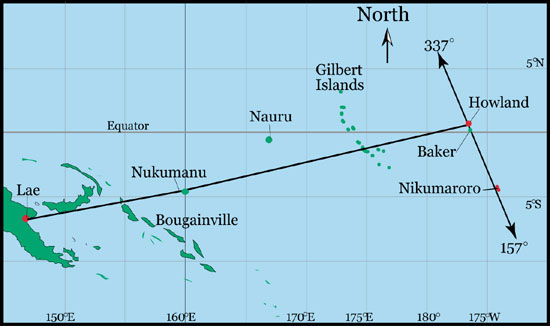|
Copyright ©2009 by Paul Niquette. All rights reserved. |
||
 TIGHAR Earhart Project used by permission
{3} Estimated Time Enroute (ETE) to Howland Island, 2,556 sm away ~ 18 hours...from which the estimated groundspeed outbound... VGSO = 2,556 sm / 18 hr = 142 mph.The flight will be flown in the presence of... {5} Winds Aloft Forecast: VWA ~ 15 mph from East-North-East (67.5o).The intended course from Lae to Howland has a... {4} True Heading for the Route of 78o......and will therefore face a direct headwind, such that the estimated true airspeed must be... VTAS = VGSO + VWA = 142 + 15 = 157 mph....which means that VGSR, the estimated groundspeed during a return flight to Lae, would benefit from VWA acting as a direct tailwind... VGSR = VTAS + VWA = 157 + 15 = 172 mph.From the last two conditions listed in the puzzle... {6} Fuel on Board at Departure ~ 1,100 gallons and......solvers are able to derive the maximum time aloft... TMTA = 1,100 gallons / 50 gallons / hour = 22 hours (with no reserve).Any number of calamities might require Amelia Earhart to consider turning back...
 With no
alternate airports available along the flight path, the
Lockheed Electra would have to return for a landing at
Lae; however, that option will be foreclosed if the
flight has flown past some enroute location, XPNR, known as the Point of No Return. With no
alternate airports available along the flight path, the
Lockheed Electra would have to return for a landing at
Lae; however, that option will be foreclosed if the
flight has flown past some enroute location, XPNR, known as the Point of No Return.
Although XPNR is an unkown, solvers will surmise that the ETE to reach XPNR from Lae plus the ETE to flight back to Lae from XPNR cannot exceed TMTA, the maximum time aloft... XPNR / VGSO + XPNR / VGSR < TMTA...which can be solved for XPNR < 1,711 sm from Lae with only 845 sm to Howland. That appears to match Choice {d} in the puzzle.
Other choices are more conservative and should not be ruled out... Choice {a} XPNR < 1,278 = 2,556 / 2. It may be counter-intuitive to some solvers that a non-zero VWA in {d} actually increases VGSR over the value in {a}.Which is not to say that no-wind aloft is not better still (excuse the triple negative). For VWA = 0, VGSO = VGSR = VTAS, and XPNR < 1,727 sm, a choice not offered in the puzzle. Choice {b} XPNR < 1,723 sm results from setting VWA = 15/2 mph, which appears to be unsafe, and besides the formulation is not logically justifiable.Call it a 'trick' if you are so inclined, but the correct solution simply makes use of one of the seven conditions that has not yet been addressed (with emphasis added)... {2} Take-off on a Primitive Runway at Lae ~ 10:00 AM Local Time  That
strongly implies there would be no runway lighting for a
landing at Lae in the dark (in 1937). Solvers of Here Comes the Sun will be
able to confirm the reasonable proposition that sunset
at Lae would darken the sky shortly after about 8:00 PM
Local Time, allowing only 12 hours aloft for Earhart and
Noonan to return and land in daylight. Thus, for... That
strongly implies there would be no runway lighting for a
landing at Lae in the dark (in 1937). Solvers of Here Comes the Sun will be
able to confirm the reasonable proposition that sunset
at Lae would darken the sky shortly after about 8:00 PM
Local Time, allowing only 12 hours aloft for Earhart and
Noonan to return and land in daylight. Thus, for...
XPNR / VGSO + XPNR / VGSR < 12 hours,Accordingly, the solution (trick and all) to the Point of No Return puzzle must be...
Nota Bene: Some solvers will protest that Amelia Earhart could fly back to Lae and merely loiter in the sky until the sun comes up at, say 7:00 AM the next morning, for a time aloft of 21 hours. Sure, but the plan was to arrive all the way at Howland three hours sooner. |